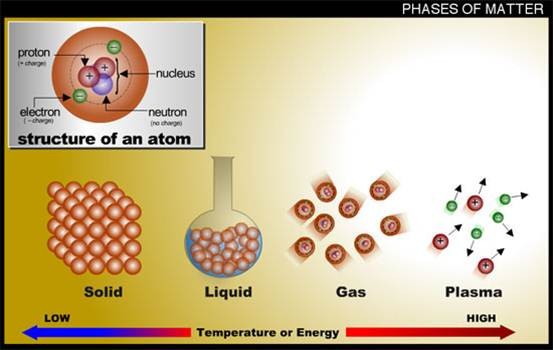The first three states of matter are solid, liquid, and gas, and matter transitions from one state to the next by the addition of energy (often in the form of heat). For example, “solid” water is ice and melts into water with the addition of heat (energy). Water is evaporated into a gas with the addition of more heat. Plasma occurs after the gas state, with the addition of more energy. When molecules of the gas are given energy in excess of their ionization potential, electrons are able to escape the electron cloud. This results in a body of positively charged ions and negatively charged electrons. These charged species can be affected by electric and magnetic fields, resulting in the production of additional excited species.
Plasma exists in many everyday forms. The glow from neon signs is a plasma, as are lightening bolts. Flames, lasers, and most of “outer space” are also plasma. In general, plasma is classified by two factors, electron number density and temperature. Electron number density refers to the no. of molecules that have ionized (lost one or more electrons) relative to the no. of neutral gas species. “plasma temperature” is a bit confusing and does not refer to whether a plasma feels hot or cold, but rather to the energy (in the units eV) of the free electrons. If there are significantly more neutral gas molecules than ionized gas molecules, the plasma may be cold to the touch, but still have very energetic electrons and thus a very high plasma temperature.
Benefits of Plasma Technology
Sustainable & Economical Technology
– No water- no wastewater stream
– No heat- no stack emissions
– Closed loop system- 90% of process gas recycled
Nanotechnology
– Very small amounts of chemistry needed
– Treat face and back independently
– No change to fabric hand or color
Atmospheric Non-Thermal Plasma Technology
– Continuous process
– No heat – treat thermal sensitive fabrics (polypropylene)
– Small footprint
Durable Water and Stain Repellent Finishes
– C6 Chemistry
– Durable to 30+ Home Launderings
Chemically active species can be produced by plasma if the proper conditions for generating plasma are chosen and the correct gases are selected. APJeT™ is expert in selecting gases & designing systems to maximize the production of these chemically active species & engg. them for the finishing of fabric & other substrates.
APJeT’s Atmospheric Pressure Plasma Jet (APPJ®)technology is a broad-based, platform technology consisting of several different apparatus and methods patents on the use of different applications and designs of plasma sources for generating and using a low temperature, highly reactive plasma for materials processing applications. APJeT uses its proprietary plasma technology to apply to fibers a nanometer-thin polymeric film that enables fabric to repel water and stains without changing its feel or appearance. By combining electrical power with a selected gas, the ionization process that occurs in the plasma produces active, gas-phase chemicals that bond to the surface of the fabric, producing unique properties.
